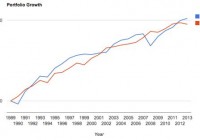In 2015, investors should be more skeptical of expert market analysis, and be humble in their approach to new investment opportunities regardless of their past success. Investors should be diversified beyond stocks that Wall Street currently loves, and be wary of investing in overpriced dividend growth stocks. Investors should prepare a list of potential investments as an inevitable correction may finally occur in 2015. Investors should focus on alternative financial media to support their investment decisions, and focus on their entire portfolio’s performance. Investors should broaden their mid-cap stock exposure and strategically invest in out-of-favor dividend stocks with potential to become classic dividend growth stocks. As 2015 rapidly approaches, set forth below are our rules for investing in stocks for 2015. Many of the rules are perennial rules that will always stay with us, and should stay with most investors throughout their investing activities. Some investing rules for 2015, however, are more specific to the current investing environment of: 1) historically low interest rates that are likely to change in the near term; 2) investors engaging in riskier investments given such low interest rates; and 3) desperate search for income causing many dividend growth stocks to be vastly overpriced. With this in mind, below is a set of rules we will be following in 2015 as we make modest adjustments to our portfolio. 1 – Be Skeptical of Pundits and Experts The overall stock market has had an extraordinary run since the dark days of 2009. Most analysts and market pundits predict market indexes to advance further in 2015. We, however, remain skeptical of expert opinions about the near-term future of stocks and the market indexes. Why? The market has had an extraordinary run, and all good things must come to an end or at least take a rest. Although market indexes have advanced strongly since 2012, we have been highly skeptical of the strong surge in the overall market indexes. In our effort to add stocks to our portfolio during such period, we focused on and purchased only stocks that were out-of-favor, including Coach, Inc. (NYSE: COH ), FMC Corporation (NYSE: FMC ) and Patterson Companies (NASDAQ: PDCO ). 2 – Be Humble when making new Investments Since the market advance began in 2009, many institutional and individual investors have experienced significant returns on investment. In addition, there are pockets of the stock market where stocks are clearly overpriced, such as certain dividend growth stocks. With great success comes human nature to begin to think of oneself as invincible. A successful investor with many successful investments in their past begins to think they too are invincible. The current bull market has made many individual investors feel like geniuses when their success is part smart stock picking, part the actions of the U.S. Federal Reserve’s low interest rate policy and part luck. With that said, leave the arrogance to the professional traders and be humble when you are making changes to your stock portfolio. Over time, the stock market tends to humble all investors on a periodic basis. 3 – Be diversified An individual investor that chooses to invest in individual stocks should focus on being diversified throughout multiple industries. If an individual investor wants to own 40 stocks, then, for example, such an investor should own a few of each of the following types of stocks: 1) food stocks, 2) industrial stocks, 3) pharmaceutical stocks, 4) software stocks, 5) utilities, 6) consumer non-discretionary stocks, 7) consumer discretionary stocks, 8) chemical stocks, and 9) technology stocks. An investor should never overweight their portfolio with one or two stocks, no matter how much Wall Street, the financial media and individual investors love the stock. We are constantly amazed at how many investors overweight their portfolio with Apple, Inc. (NASDAQ: AAPL ) stock. No matter how wonderful you think AAPL is as an investment, one day the company will stumble and fall for a period of years. When AAPL does stumble you will not want to be overweight on the stock. Stay diversified. 4 – Be wary of overpriced dividend stocks The last several years have been extraordinarily kind to dividend growth stocks and any investor in such stocks. Now, however, is the time to turn more cautious on this crowded trade. The success of dividend growth stocks over the last several years has been due in large part to the U.S. Federal Reserve’s ultra-low interest rate policy to boost the sagging U.S. economy. The Federal Reserve’s policy has forced many investors to take on more risk to provide income. With banks providing near zero interest rate returns on bank accounts, investors have flocked to dividend growth stocks. With the Federal Reserve indicating that interest rates are set to rise in mid 2015, investors should begin to look more skeptically at dividend growth stocks to avoid overpaying for such stocks. 5 – Develop a List of Potential Investments Whether overall market indexes are hitting new highs or new lows, we believe there are always opportunities to invest in individual stocks in the markets. With that said, we prefer to invest in out-of-favor stocks when the overall market corrects more significantly. Therefore, we have a list of about 50 or so stocks that we are interested in under the right circumstances. Most of such 50 stocks we will never buy as such stocks will never reach a price that we believe is fair for the stock. There will be, however, instances where we will be able to buy a few of the stocks on our list each year. The purpose of such a list then is to provide us with a rough guide of what we can add to our portfolio when the stock market unexpectedly provides us with the opportunity to make a well-timed purchase of an out-of-favor stock that we believe in. 6 – Be prepared for a market correction We believe that the lack of a correction in the last few years has made investors complacent and feel invincible. Investors have forgotten what a severe correction looks like. For us, a severe correction tends make us feel that all we felt we knew about the stock market has been thrown out the window. A severe correction makes us look at our stocks in disbelief as they drop in multiple point increments day after day to levels we never thought imaginable. The feelings of being an investor during a severe market correction (such as the 2008-09 correction) are quite humbling. Being prepared for a correction means for us to: 1) stick with the investments we have, 2) not panic, 3) continue to reinvest dividends, 4) make new investments, and 5) stay calm. A more experienced investor sees a market correction as an opportunity rather than a tragic permanent event. 7 – Seek out alternative financial media discussions Anyone who has read some of our articles knows that we hold Wall Street, analysts and mainstream financial media in very low regard. Much of the financial news coming out of the most mainstream of news sources engages in loud headlines that send out signals of extreme euphoria or extreme pessimism regarding overall markets and individual stocks. We believe that such extreme headlines serve to confuse individual investors and push them to make rash buying and selling decisions. Apart from our favorite mainstream financial news source, Barron’s, we believe all other mainstream financial media should be viewed in an extremely skeptical manner. We also believe that the shouting headlines of mainstream financial media is what has driven many individual investors to Seeking Alpha for more rational discourse on overall markets and individual stocks. Aside from Barron’s and Seeking Alpha, we believe individual investors should seek out investing information from secondary sources. There are paid sources such as Morningstar, which we believe are very valuable to the individual investor and are worth the subscription fee. In addition, we believe that investors should conduct Internet searches for the companies they have invested in or are interested in investing in. Local newspapers, technological newspapers, industry journals and highly respected blogs are valuable sources of information for individual investors and can give greater clarity to an individual investor about what a company is really about. 8 – Focus on the whole of your portfolio We once told another investor that our portfolio of stocks was similar to a parent’s children. If a parent has 4 children and 3 have done well in school and are bound for excellent colleges, but one child is struggling in school, the parent will feel like a failure. Well, of course, a good parent wants all of their children to “succeed.” Our point is, however, that focusing on a minority of underperforming stocks in an overall portfolio prevents an individual investor from understanding and appreciating the successes of their portfolio. Just as children can reach their potential at different stages of their life, so too can stocks appreciate and perform well in varied periods. An individual investor with a portfolio of 40 to 50 stocks will recognize that individual stocks will perform well over multi-year periods, but will also move sideways or downward for multi-year periods as well. Over the long term, even the most successful stocks have their sideways and downward trading periods. Once an investor accepts that not all of their stocks will perform well every single investing year, the sooner they will accept that they do not need to trade in and out of stocks constantly. 9 – Seek out Mid Cap Stocks The vast majority of our stocks are “mega-market capitalization” companies with market capitalizations ranging from $40 to $50 billion to hundreds of billions of dollars. While “mega-market capitalization” stocks do have a place in an individual investor’s portfolio, lately we have come to appreciate owning stocks of companies in the $4 to $15 billion dollar market capitalization range. In particular, we focus on dividend paying mid-cap stocks that are out-of-favor with takeover potential. Mid-cap stocks offer greater share price appreciation, lower outstanding share counts and takeover potential. Our recent purchases of COH, FMC and PDCO fit into the mid-cap category that we are beginning to favor as an addition to the mega-market capitalization stocks that form the majority of our portfolio. We now believe that up to 25 percent of any individual investor’s portfolio should be comprised of such mid-cap stocks. 10 – Increase dividend income stream through strategic purchases Our final investing rule for 2015 is a rule that we have been following for many years. Now, however, as we indicated in an earlier rule, dividend growth stock investing has become a crowded trade, which makes us wary of investing in many dividend growth stocks. With that in mind, an investor must alter their dividend investing approach to adapt to the current market climate. Instead of focusing solely on the current yield of a stock and the length of years a company has raised its dividend, an investor should focus on a company’s recent dividend history and the potential for dividend growth in the company’s upcoming years. To use a baseball analogy, instead of trying to buy an expensive free agent baseball player with extraordinary past performance, look for a lower-priced minor-league baseball player at a more reasonable price with potential. A company with a 5-year history of dividend increases, a 1 percent dividend yield, and the potential to increase dividends for years to come is likely a better choice today than the most highly publicized (and overpriced) dividend growth stocks. In the current market climate, individual investors need to think differently about dividend growth investing and increasing their dividend income stream.

